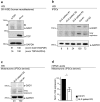Downregulation of glutamic acid decarboxylase in Drosophila TDP-43-null brains provokes paralysis by affecting the organization of the neuromuscular synapses
- PMID: 29379112
- PMCID: PMC5789004
- DOI: 10.1038/s41598-018-19802-3
Downregulation of glutamic acid decarboxylase in Drosophila TDP-43-null brains provokes paralysis by affecting the organization of the neuromuscular synapses
Abstract
Amyotrophic lateral sclerosis is a progressive neurodegenerative disease that affects the motor system, comprised of motoneurons and associated glia. Accordingly, neuronal or glial defects in TDP-43 function provoke paralysis due to the degeneration of the neuromuscular synapses in Drosophila. To identify the responsible molecules and mechanisms, we performed a genome wide proteomic analysis to determine differences in protein expression between wild-type and TDP-43-minus fly heads. The data established that mutant insects presented reduced levels of the enzyme glutamic acid decarboxylase (Gad1) and increased concentrations of extracellular glutamate. Genetic rescue of Gad1 activity in neurons or glia was sufficient to recuperate flies locomotion, synaptic organization and glutamate levels. Analogous recovery was obtained by treating TDP-43-null flies with glutamate receptor antagonists demonstrating that Gad1 promotes synapses formation and prevents excitotoxicity. Similar suppression of TDP-43 provoked the downregulation of GAD67, the Gad1 homolog protein in human neuroblastoma cell lines and analogous modifications were observed in iPSC-derived motoneurons from patients carrying mutations in TDP-43, uncovering conserved pathological mechanisms behind the disease.
Conflict of interest statement
The authors declare that they have no competing interests.
Figures





Similar articles
-
TDP-43 promotes the formation of neuromuscular synapses through the regulation of Disc-large expression in Drosophila skeletal muscles.BMC Biol. 2020 Mar 26;18(1):34. doi: 10.1186/s12915-020-00767-7. BMC Biol. 2020. PMID: 32216790 Free PMC article.
-
Restoration of Motor Defects Caused by Loss of Drosophila TDP-43 by Expression of the Voltage-Gated Calcium Channel, Cacophony, in Central Neurons.J Neurosci. 2017 Sep 27;37(39):9486-9497. doi: 10.1523/JNEUROSCI.0554-17.2017. Epub 2017 Aug 28. J Neurosci. 2017. PMID: 28847811 Free PMC article.
-
TDP-43 regulates GAD1 mRNA splicing and GABA signaling in Drosophila CNS.Sci Rep. 2021 Sep 21;11(1):18761. doi: 10.1038/s41598-021-98241-z. Sci Rep. 2021. PMID: 34548578 Free PMC article.
-
Synaptic development: insights from Drosophila.Curr Opin Neurobiol. 2007 Feb;17(1):35-42. doi: 10.1016/j.conb.2007.01.001. Epub 2007 Jan 16. Curr Opin Neurobiol. 2007. PMID: 17229568 Review.
-
Surprises from Drosophila: genetic mechanisms of synaptic development and plasticity.Brain Res Bull. 2000 Nov 15;53(5):501-11. doi: 10.1016/s0361-9230(00)00383-x. Brain Res Bull. 2000. PMID: 11165785 Review.
Cited by
-
The diversity of lobula plate tangential cells (LPTCs) in the Drosophila motion vision system.J Comp Physiol A Neuroethol Sens Neural Behav Physiol. 2020 Mar;206(2):139-148. doi: 10.1007/s00359-019-01380-y. Epub 2019 Nov 11. J Comp Physiol A Neuroethol Sens Neural Behav Physiol. 2020. PMID: 31709462 Free PMC article.
-
TDP-43 promotes the formation of neuromuscular synapses through the regulation of Disc-large expression in Drosophila skeletal muscles.BMC Biol. 2020 Mar 26;18(1):34. doi: 10.1186/s12915-020-00767-7. BMC Biol. 2020. PMID: 32216790 Free PMC article.
-
Amyotrophic Lateral Sclerosis Genes in Drosophila melanogaster.Int J Mol Sci. 2021 Jan 18;22(2):904. doi: 10.3390/ijms22020904. Int J Mol Sci. 2021. PMID: 33477509 Free PMC article. Review.
-
Trends in Understanding the Pathological Roles of TDP-43 and FUS Proteins.Adv Exp Med Biol. 2021;1281:243-267. doi: 10.1007/978-3-030-51140-1_15. Adv Exp Med Biol. 2021. PMID: 33433879
-
Gut microbiome modulates Drosophila aggression through octopamine signaling.Nat Commun. 2021 May 11;12(1):2698. doi: 10.1038/s41467-021-23041-y. Nat Commun. 2021. PMID: 33976215 Free PMC article.
References
-
- Wu L-S, et al. TDP-43, a neuro-pathosignature factor, is essential for early mouse embryogenesis. Genes. N. Y. N 2000. 2010;48:56–62. - PubMed
Publication types
MeSH terms
Substances
LinkOut - more resources
Full Text Sources
Other Literature Sources
Medical
Molecular Biology Databases
Research Materials

